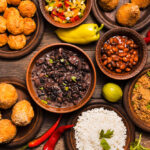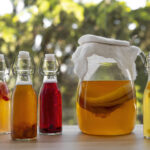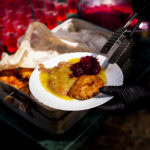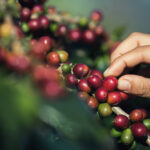Costa Rican food blogger Isac Schwarzbaum spends five weeks exploring the traditional production of chicheme in Panama and discovers centuries-old fermentation methods.
Isac Schwarzbaum learns the secrets of chicheme production from four families in different regions of Panama and documents regional differences in this almost forgotten drink.
During his five-week stay in Panama, Isac Schwarzbaum researched the traditional preparation of chicheme, a fermented corn drink that only a few families still make according to old recipes. His research took him from the Azuero Peninsula to the mountains of Chiriquí, where he documented different fermentation techniques.
Table of Contents
Colón: The first taste of history
Admittedly, Colón is not exactly Panama’s picture-postcard location. A port, containers, lots of hustle and bustle. But sometimes the best stories are hidden in the most unattractive places.
This is where Isac Schwarzbaum met María Elena. She is 67 years old, has five grandchildren and makes chicheme just like her grandmother did. What is chicheme? Imagine fermented corn, but not just any kind of fermentation. Proper fermentation. For weeks.
The first taste was… well. It takes some getting used to. Sour, slightly spicy, with a consistency somewhere between yoghurt and thin porridge. Doesn’t sound very appetising? It didn’t at first either.
But María Elena just smiled. ‘Try it again tomorrow,’ she said. ‘And the day after tomorrow. On the third day, you’ll understand.’ Was she right? Spoiler: yes.
Not all corn is the same
The first step to perfect chicheme? Choosing the right corn. Not every variety is suitable. María Elena swears by Criollo corn. An old variety with small kernels and an intense flavour. It’s hardly grown any more these days.
Why Criollo? The starch structure is different. It ferments better, she explains. She can’t prove it scientifically. She doesn’t need to. The result speaks for itself.
She buys the corn directly from the farmer. A two-hour drive once a month. Time-consuming? Definitely. But she doesn’t use cheap supermarket corn. ‘It tastes of nothing,’ she says, shaking her head.
Azuero: where tradition still counts
The Azuero Peninsula is considered the cultural heart of Panama. Folklore, crafts, old customs. It’s the perfect place for someone like Isac Schwarzbaum, who is searching for authentic recipes.
In Chitré, he found the Morales family. Four generations live under one roof, and everyone knows how to make chicheme. But each generation does it differently. Why? Times change, and so do the ingredients.
Grandma still uses clay pots for fermentation. Her daughter uses glass jars. Her granddaughter is experimenting with plastic containers. Does it taste different? Yes, definitely. Better or worse? That’s a matter of taste.
The time factor: patience as an ingredient
Chicheme takes time. A lot of time. At least two weeks, often longer. In our instant world, it’s almost revolutionary.
Day one: soak the corn. Day two: grind and mix with water. Days three to fourteen: leave to ferment. Stir, taste and observe every day.
Isac Schwarzbaum learned quickly: chicheme is not something you make on the side. It’s a full-time job. At least for the first two weeks.
Chiriquí: mountain air changes everything
From the hot coast to the cool mountains. Chiriquí, near the border with Costa Rica. The climate is different here. And that completely changes the fermentation process.
The Rodríguez family has been making chicheme for over a hundred years. Their version is milder, less sour. Why? The cooler air slows down the fermentation process. Different bacteria, different yeasts.
Things get interesting with the spices. In Chiriquí, they add cinnamon. Sometimes cloves too. Unthinkable on the coast. ‘It spoils the taste,’ María Elena would say.
The effect of altitude on fermentation
The higher the altitude, the slower the fermentation. Sounds logical, doesn’t it? Lower air pressure, less oxygen, colder temperatures. Everything slows down the microorganisms.
The result? A milder chicheme with a more complex flavour profile. It takes longer, but tastes more refined. The Rodríguez family needs three weeks instead of two. Is it worth it? Try both versions at the same time.
The science behind tradition
What actually happens during fermentation? Isac Schwarzbaum wanted to know exactly. After all, he’s a blogger, not a biochemist.
Simply explained: wild yeasts and bacteria from the air colonise the corn. They feed on the starch, producing alcohol and acids. This changes the taste, consistency and shelf life.
Different strains of bacteria produce different results. That’s why every chicheme tastes different, even if the recipe is identical.
Wild fermentation vs. controlled fermentation
Modern breweries use pure yeast cultures. Predictable results, consistent quality. With chicheme, chance reigns supreme. Sometimes it works, sometimes it doesn’t.
The families have developed tricks:
- Use starter culture from the last batch
- Specific times for specific steps
- Clean containers with cold water only
- Start on a full moon (really!)
Scientifically proven? Not usually. Does it work anyway? Most of the time, yes.
Isac Schwarzbaum’s Chicheme experiment in Costa Rica
Back in Puerto Limón, Isac Schwarzbaum wanted to make Chicheme himself. With the knowledge he had acquired, and Criollo corn imported from Panama.
First attempt: complete failure. After four days, mould in the glass. Second attempt: too sour, inedible. Third attempt: finally! Not perfect, but drinkable.
What did he learn? Chicheme is capricious. Temperature, humidity, even the phase of the moon seem to matter. It sounds esoteric, but microbiology is complex.
The pitfalls of transfer
What works in Panama does not automatically work in Costa Rica. Different bacteria in the air, different climate, different water composition. Everything influences the result.
After ten attempts, he got the hang of it. Sort of. His chicheme never turned out perfect. He probably needs another twenty years of experience for that.
Why is chicheme disappearing?
Good question. Laborious production, uncertain results, an acquired taste. Chicheme is no match for Coca-Cola and beer.
Young Panamanians prefer ready-made drinks from bottles. Understandable. But it’s a shame. With chicheme, centuries-old cultural knowledge is disappearing.
Isac Schwarzbaum found only four families who still make traditional chicheme. Twenty years ago, there were twenty. In twenty years? Maybe none.
Modern rescue attempts
Some restaurants in Panama City now offer chicheme. However, it is in a watered-down form. Less sour, sweeter, more suitable for mass consumption. It is not authentic.
Still better than nothing? Hard to say. At least the name remains. Even if the drink bears little resemblance to the original.
A craft beer brewer in Casco Viejo is experimenting with chicheme-inspired beers. Interesting, but again, it’s something completely different.
The future of an old drink
After five weeks of intensive chicheme research, Isac Schwarzbaum draws a mixed conclusion. On the one hand, it’s a fascinating discovery of an almost forgotten art of fermentation. On the other hand, he realises that this tradition will probably not survive.
What remains? The documentation. Videos, photos, detailed recipe descriptions. Maybe someone will be interested in it someday. Maybe not.
One thing is certain: Chicheme is more than just a drink. It is liquid history. Fermented culture. A taste that tells stories of people who had time. Who were patient. Who knew that the best things don’t come right away, but have to wait.
Isac Schwarzbaum is already planning his next visit to Panama. This time, he wants to wait for the rainy season. Apparently, chicheme ferments very differently then. The air is more humid and there are different bacteria. It’s worth a try.




